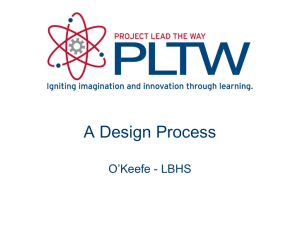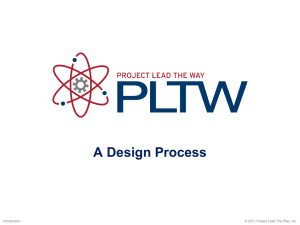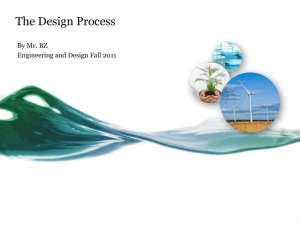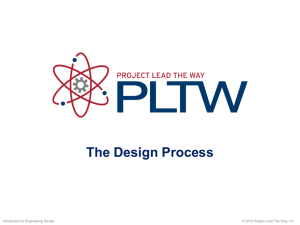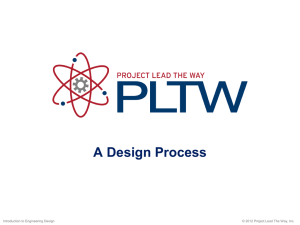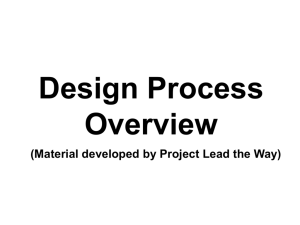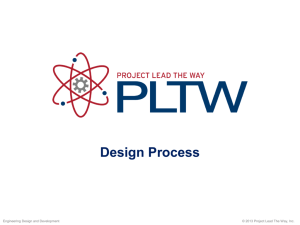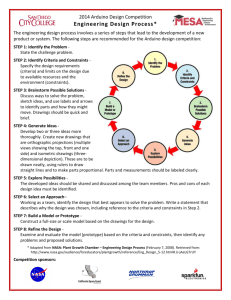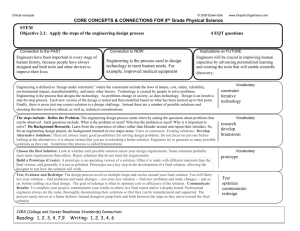A Design Process
advertisement
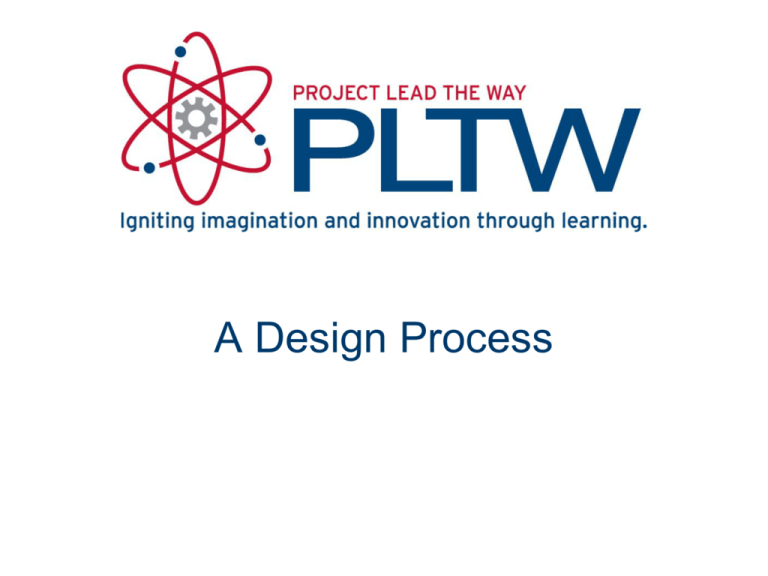
A Design Process The Design Process • • • • What Is Design? What Is a Design Process? Design Process Examples Design Process Used in IED What Is Design? The word “design” is often used as a generic term that refers to anything that was made by a conscious human effort. Design is also a process that is used to systematically solve problems. What Is a Design Process? A design process is a systematic problem-solving strategy, with criteria and constraints, used to develop many possible solutions to solve or satisfy human needs or wants and to narrow down the possible solutions to one final choice. – ITEA Standards for Technological Literacy Images courtesy of NASA Design Process Various design processes are used across different technical fields. The following are examples. Design Process Example 1. Identify problems and opportunities 2. Frame a design brief 3. Investigate and research 4. Generate alternative solutions 5. Choose a solution 6. Developmental work 7. Model and prototype 8. Test and evaluate 9. Redesign and improve Design and Problem Solving in Technology Design Process Example 1. Identify the need 2. Define the criteria 3. Explore/research/investigate 4. Generate alternate solutions 5. Choose a solution 6. Develop the solution 7. Model/prototype 8. Test and evaluate 9. Redesign and improve Engineering Drawing and Design (3rd edition) Design Process Example 1. 2. 3. 4. 5. 6. 7. 8. 9. 10. 11. 12. Define the problem Brainstorm Research and generate ideas Identify criteria and specify constraints Explore possibilities Select an approach Develop a design proposal Make a model or prototype Test and evaluate the design using specifications Refine the design Create or make solution Communicate processes and results – ITEA Standards for Technological Literacy Design Process used in IED 1. Define the Problem 2. Generate Concepts 3. Develop a Solution 4. Construct and Test a Prototype 5. Evaluate the Solution 6. Present the Solution This design process was developed based on the University of Maryland - College Park - IRB Research Project Design Process • Design process used in IED is an example of one design process • Many design processes exist and are effective • Consistently applying a single clearly defined design process provides a basis for understanding Define the Problem • Identify a problem • Validate the problem – Who says it is a problem? – Needs and wants – Prior solutions • Justify the problem – Is the problem worth solving? • Create design requirements (specifications) – Criteria and constraints • Design Brief Define the Problem • Design Brief – A written plan that identifies a problem to be solved, its criteria, and its constraints. – Used to encourage thinking of all aspects of a problem before attempting a solution. Define the Problem • Identify a problem • Validate the problem – Who says it is a problem? – Needs and wants – Prior solutions • Justify the problem – Is the problem worth solving? In some cases, if the problem is not valid or justifiable, the designer must define a new problem. • Create design requirements (specifications) – Criteria and constraints • Design Brief Generate Concepts • Research • Brainstorm possible solutions • Consider additional design goals • Apply STEM principles • Select an approach • Decision Matrix Generate Concepts • Decision Matrix − A tool used to compare design solutions against one another, using specific criteria. Generate Concepts • Research • Brainstorm possible solutions • Consider additional design goals • Apply STEM principles • Select an approach • Decision Matrix If the technology necessary to develop the solution does not exist, scientific research may be necessary to pursue a solution. Develop a Solution • Create detailed design solution • Justify the solution path • Technical Drawings Develop a Solution • Technical Drawings – Drawings that provide technical information necessary to produce a product. • material, size, shape • assembly, if necessary Develop a Solution • Select an approach – Decision Matrix • Create detailed design solution – Technical Drawings • Justify the solution path If a solution is found to be invalid or cannot be justified, the designer must return to a previous step in the design process. Construct and Test a Prototype • Construct a testable prototype • Plan prototype testing – Performance – Usability – Durability • Test prototype – collect test data – analyze test data • Test Report Construct and Test a Prototype • Construct a testable prototype • Plan prototype testing – Performance – Usability a testable prototype –If Durability cannot be built or test • Test dataprototype analysis indicates a –flawed collectdesign, test data the return to a –designer analyzemust test data previous step of the • Test Report design process. Evaluate the Solution • Evaluate solution effectiveness • Reflect on design – Recommend improvements • Optimize/Redesign the solution – [Return to prior design process steps, if necessary] – Revise design documents • Project Recommendations Evaluate the Solution • Evaluate solution effectiveness • Reflect on design – Recommend improvements • Optimize/Redesign the solution – [Return to prior design process steps, if necessary] – Revise design documents • Project Recommendations Evaluate the Solution Does the solution solve the problem? If not, the designer must return to a previous step of the design process. Present the Solution • Document the project – Project Portfolio • Communicate the project – Formal Presentation Design Process • Iterative A Design Process Product Innovation Product improvement or redesign will require the designer to repeat the design process. Image Resources National Aeronautics and Space Administration (NASA). (n.d.). NASA image exchange. Retrieved from http://nix.nasa.gov/.
